Chapter: Principles of Management : Organizing
Differences Between Formal and Informal Organization
DIFFERENCES BETWEEN FORMAL AND INFORMAL ORGANIZATION

Formal Organization
1. Formal organization is established with the explicit aim of achieving well-defined goals.
2. Formal organization is bound together by authority relationships among members. A hierarchical structure is created, constituting top management, middle management and supervisory management.
3. Formal organization recognizes certain tasks which are to be carried out to achieve its goals.
4. The roles and relationships of people in formal organization are impersonally defined
5. In formal organization, much emphasis is placed on efficiency, discipline, conformity, consistency and control.
6. In formal organization, the social and psychological needs and interests of members of the organization get little attention.
7. The communication system in formal organization follows certain pre-determined patterns and paths.
8. Formal organization is relatively slow to respond and adapt to changing situations and realities.
Informal Organization
1. Informal organization springs on its own. Its goals are ill defined and intangible.
2. Informal organization is characterized by a generalized sort of power relationships. Power in informal organization has bases other than rational legal right.
3. Informal organization does not have any well-defined tasks.
4. In informal organization the relationships among people are interpersonal.
5. Informal organization is characterized by relative freedom, spontaneity, by relative freedom, spontaneity, homeliness and warmth.
6. In informal organization the sociopsychological needs, interests and aspirations of members get priority.
7. In informal organization, the communication pattern is haphazard, intricate and natural.
8. Informal organization is dynamic and very vigilant. It is sensitive to its surroundings.
Related Topics